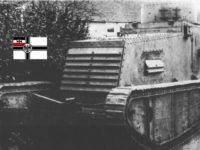With the successes of the light French Renault FT17 chariots, the Army High Command has come to realize that for a fast war and the exploitation of the momentum of an offensive, fast combat vehicles are much better suited than the slow and lumbering assault tanks. For this purpose, the demand for such a vehicle was also loud on the German side.
Development:
On December 29, 1917, the first draft of the chief engineer of the highest army command was already available. In January, however, the draft was rejected on the grounds that the armor was too weak. At the same time, however, the Army Command prepared a draft of its own in cooperation with Krupp. Later, when the chief force was involved in the project again, he submitted plans already drafted for a light chariot called LK I.
The vehicle had about 8 tons of weight, a top speed of 12 to 15km / h, inclines of up to 45 degrees and a crossing of trenches up to 2 meters should be possible. The armament was a 5.7cm rapid-fire cannon.
The first prototype was introduced in March 1918 and considered suitable by the Army High Command. Subsequently, the development of a LK II was driven forward, which should be more armored.
On July 23, 1918, the draft for the LK II was submitted. This variant was equipped with a 5.2cm cannon and a machine gun. Also, the model was a bit longer and therefore better suited for the terrain.
The planned series production for the LK II was to start in December 1918 and from April 1919 about 200 pieces will be produced. Since it was determined during target practice on August 29, 1918, that the build-up for the built-in 5.7 cm cannon was too weak, the order was changed to a 3.7 cm cannon.
After the war:
At the end of the war, a few vehicles of the type LK II were already completed, dozens more were still in production. Under the Treaty of Versailles, a larger number of LK II cars were completed and sold to Sweden where they were put as Stridwagn m21 in the service of the Swedish military.
Although a draft version of the LK III version was available to the highest army command before the end of the war, it could no longer be implemented.
Technical specifications:
| Designation: | Light combat car II (canon version) |
| Length: | 5,08 meters |
| Width: | 1,95 meters |
| Height: | 2,68 meters |
| Mass: | 8,5 tons |
| Maximum speed: | 14km/h |
| Power: | 40 - 60HS |
| Fuel consumption: | 150 litres / 100 km |
| Reach: | 70 kilometre |
| Crew: | 3 Man |
| Armament: | 3.7 cm cannon |
You can find the right literature here:
Armored Vehicles of the German Army 1905-1945 (Spielberger German Armor and Military Vehicle)

Armored Vehicles of the German Army 1905-1945 (Spielberger German Armor and Military Vehicle) Hardcover – July 29, 2008
This classic, definitive series continues with this volume on German armored vehicles from 1905-1945. Spielberger, a leading expert in the field of German military vehicles, presents the wide variety of four-, six-, and eight-wheeled types and their wide range of uses in this richly illustrated technical documentation. Types include the WWII era Sd.Kfz.231, Sd.Kfz.222, Sd.Kfz.232, and many others from a wide variety of manufacturers.
German Panzers 1914–18 (New Vanguard)
Panzer warfare is synonymous with the Wehrmacht of World War II. This book examines the story of the Panzer's more mysterious ancestors, the little-known panzers of the Great War. Germany was very slow to develop armored vehicles compared to Britain and France. Early attempts such as the Marienwagen of 1915 were technical failures, discouraging further design efforts until the utility of the tank was proven by the British and French in 1916-17. Efforts to catch-up proved difficult, and only a couple dozen German A7V tanks were completed in time to take part in the final campaigns of 1918. As a result, the majority of German panzer units actually used captured British tanks, the Beutepanzer. This book will trace the development of German panzers of the Great War, including the A7V and its intended but unfinished stablemates. Also included will be an overview of the use of panzers by the German Army in World War I including both A7V and Beutepanzer units.
The German A7V Tank and the Captured British Mark IV Tanks of World War I (A Foulis military book)

The German A7V Tank and the Captured British Mark IV Tanks of World War I (A Foulis military book) Hardcover – December 1, 1990
, 240 pages illustrated with over 25 black ans white photographs and line drawings, SIGNED by both Maxwell Hundleby and Rainer Strasheim on a label stuck down to the front pastedown
German Tanks in World War I: The A7V and Early Tank Development (Schiffer military history)

German Tanks in World War I: The A7V and Early Tank Development (Schiffer military history) Paperback – July 1, 1990
This book covers the earliest forms of German armored fighting vehicles used primarily in WWI.
This post is also available in:
 Deutsch (German)
Deutsch (German)  Français (French)
Français (French)  Italiano (Italian)
Italiano (Italian)  简体中文 (Chinese (Simplified))
简体中文 (Chinese (Simplified))  Русский (Russian)
Русский (Russian)  Español (Spanish)
Español (Spanish)  العربية (Arabic)
العربية (Arabic)


















